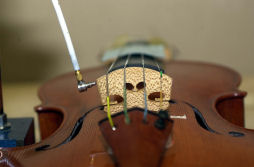The question of why some violins are so much more valuable than others has fascinated musicians and scientists for a long time.

Quite a lot is now known about the acoustics of the violin, but virtually nothing is known about the human capability for perception, discrimination and judgement of the sounds of violins with particular measurable acoustical properties. This is a very significant gap, since perceptual judgements obviously define what makes a violin different from other bowed-string instruments, and one violin different from another. A project to fill this gap has recently been started by Professor Jim Woodhouse, involving a collaboration between three departments. Professor Jim Woodhouse and Dr Claudia Fritz from the Department of Engineering, Dr Ian Cross from the Faculty of Music and Professor Brian Moore from the Department of Experimental Psychology.
The ultimate aim of this research is to be able to answer the typical question that a violin maker will ask: "What will happen to the sound if I change such-and-such a constructional detail?". To answer this question, we start by measuring the forces recorded by piezoelectric sensors on a violin bridge, while the violin is being played normally. These recordings are stored as standard force functions, which can then be applied to different violins to hear how they sound without having to worry about any complications being caused by variations in playing. Instead of achieving this by using a robotic violinist which repeats the same piece on a variety of real violins, the tests are virtual. The standard force functions are applied to a computer model, which generates an accurate prediction of the sound of the violin using digital filters.
Once the violin response is represented in digital filter form, it becomes very easy to make controlled variations of a kind which would be almost impossible to achieve by physical changes to a violin. The typical process is to start from the measured response of a chosen violin, as illustrated in the picture, then use that as a basis for a number of modified "virtual instruments" in which, for example, individual resonances are changed in frequency, amplitude or damping. Psychoacoustical test methods can then be used to find the threshold for detection of any particular change, and also to obtain statistically significant data on quality judgements made by listeners.

